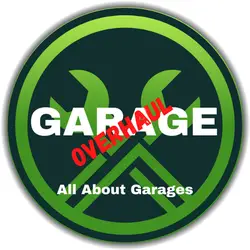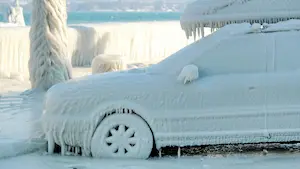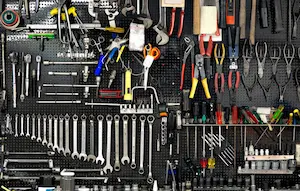How to Garage a Car (Complete Guide)
This post contains affiliate links.
Maybe you don’t need your car for a while for whatever reason. Perhaps you are leaving town for a long time while on a job, extended vacation, deployed overseas, or got a new car. Maybe you have a summer convertible, and winter arrives.
Storing a car for extended periods needs some preparations to ensure your car works fine when you return to it. This includes cleaning the car, changing the liquids, preserving the fuel, charging the battery, preventing brake fusing, flat spots on tires, and critters from making it home.
We also look at what happens when the car stays still for years and how to bring vehicles out of storage.
How Long Can You Store a Car Without Driving It?
This depends on a lot of factors discussed in this article. Cars should be driven once or twice a year at a minimum to ensure all the parts and gaskets keep working correctly. If it’s a project car without any liquids, you can store it almost indefinitely.
How Often Should You Start a Parked Car?
Two weeks to two months. Depending on the battery condition. If the battery is at the end of life, it won’t hold a charge for more than days without idling or driving.
Let the car run for 15-20 minutes until the engine gets to normal operating temperature. This charges the battery. But you should really drive even a little bit around the neighborhood. This will keep the brakes, transmission, power steering, AC, suspension and gaskets, and other parts in operating condition.
It would be even better to drive over 50 mph and at least 10 miles and over 30 minutes.
The Liquids
Cars have many liquids, including motor oil, gearbox oil, power steering oil, brake fluids, engine coolant, washer fluid, and AC coolant.
Motor Oil
- Motor oil gets dirty from contaminants and deteriorates over time because of temperature fluctuations.
- If you store your car longer times, it’s a good idea to change at least motor oil. Preferably all the oils.
- Oil loses its properties over time naturally and when the vehicle is driven.
Observe the Color and Consistency
- If the oil is thick, gritty, and the color is dark. It’s time to change the oil no matter how many miles you have driven with the oils.
Brake Fluid
- Brake fluid makes the hydraulic brakes work. It also absorbs moisture and needs to be changed regularly or after prolonged storage. If the fluid color is dark, it’s time to change them.
Engine Coolant
- Radiator fluid cools the engine and lubricates the water pump. The coolant needs to have antifreeze and lubricating properties, so only water is not enough.
- Antifreeze keeps the water freezing into the engine and damaging hoses. Lubricating properties keep the water pump going.
Washer Liquid
- Keeps the windshield clean. This also needs to have antifreeze properties in cold climates to keep the washer reservoir from freezing.
AC Coolant
- The car AC should be used regularly to keep the air conditioner parts in working order.
How Long Can Fuel Sit in a Car?
Regular gasoline only lasts about 3-6 months without preservatives or stabilizers. When gasoline gets old, its chemical properties change. Your car could suffer problems like not starting, rough sounding idle, ignition problems, and loss of power.
Diesel will last at least a year before it begins to degrade. Expired diesel provides less power and can lead to clogs in the fuel system.
Organic-based ethanol can lose combustibility in just three months.
Bad fuel will have a dark or muddy appearance, and it will smell different. Almost spoiled compared to standard fuel.
In all these cases, it’s necessary to remove the ruined fuel from the tank. Bad fuel can cause damage to the motor and create blockages in the whole fuel system and will be a costly repair.
When you drive your car, it will keep the fuel from getting stagnant, and you will naturally fill it up with fresh fuel every month or two. It’s also good to top-off the tank when you fill it. That way, you will prevent moisture and oxygen in the tank, which causes corrosion.
If you are building a car or storing a vehicle longer than a year, it’s a good idea to drain the fuel system completely.
A fuel stabilizer(paid link) is an additive that makes the fuel last longer. It’s mixed into a full tank of gas and can make the fuel last one to two years instead of 3-6 months.
The Battery
The car alternator charges the battery when the car is running. Without any kind of charging, the battery eventually dies due to parasitic draining (slow battery discharge over time. because of the cars computer and clock, radio, and maybe poorly grounded wires)
When you start your car, you should let the engine run 15-20 minutes to refill the battery. Turn off all the car electronics, including AC.
Suppose the car will stay in one place for a long time. In that case, it’s better to disconnect the negative battery cable to prevent parasitic draining.
You can also install a battery tender if you have an outlet available nearby. This will keep the battery in operating order. Another option is to remove the battery from the car and store the battery in a safe place and charge it from time to time.
If you remove the battery, contact the manufacturer or other experts to ensure removing the battery does not confuse the on-board computers. And that you have access codes to devices such as alarm and stereo.
The difference between a trickle charger and a generic car battery charger is that the trickle charger sends the minimal amount of constant electricity supply to maintain the ideal battery life.
- A healthy battery should show a reading of 12.4V – 12.9V on a voltmeter when the car is not running. When the vehicle is running, the voltage should be between 13.7 and 14.7
- If the battery isn’t fully charged, it will diminish to 12.4V at 75%
- 12V when it’s only operating at 25%,
- and down to 11.9V when it’s completely discharged.
The car needs to be driven longer in cold climates because cold batteries won’t take charge so fast than already warm batteries.
The Brakes
Cars are designed to be driven. The brakes will rust very fast, and the brake pads start to fuse with the brake disks if the vehicle is not driven. If the car is in one place for a long time, it is better to not use the parking brake. You can instead use tire stoppers to prevent the car from moving.
The Tires
Tires are meant to be rolling, and when tires are stationary for a long time and the weight of the car presses on them, the tires could develop flat spots. This happens faster in cold temperatures and vehicles with high-profile tires.
Driving the car in between storage time prevents flat spots effectively. But if the vehicle is stationary for a very long time, the flat areas might become permanent, and the tires are ruined.
If your car is going to be in storage for months or years. Put the car in jack stands(paid link) in all four corners.
You can also over-inflate the tires to the allowed maximum when storing the car for 6-12 months.
You can take the weight off the tires completely using jack stands. This is not necessarily recommended with cars with air-adaptive suspension or very old cars prone to sagging frames.
Consult your owner’s manual to find the stands’ proper locations; this will prevent chassis warpage.
Other Rubber Parts
Cars have plenty of rubber parts like hoses and belts. They can also dry out and crack when not used. If a vehicle is stored for a very long time, these parts need to be often replaced before taking the car back to usage. Gaskets can also dry and start to leak.
The Critters
Mice and other critters like warm places with a lot of nest supplies like your garage and car. If you are storing your vehicle in the garage, it might become mice city in no time. You could cover the air intake and exhaust pipe with steel wool to prevent them from getting in. Peppermint oil(paid link) and mothballs(paid link) are effective repellents too. You can also place traps(paid link) if someone can check the garage and inside of the car sometimes.
Is It Bad to Let a Car Sit for a Week?
Nothing happens in a week. Your car is fine. IF you have a really good battery, you can go without driving for weeks or even two to three months. But it’s better to start the car once a week or once two weeks and drive around even a little bit but preferably longer.
New cars drain batteries faster because of all the electronics.
What Happens if I Don’t Start My Car for 6 Months
Cars are designed to be driven, and many things happen when they stay at one place too long.
- The battery is probably dead.
- After 6 months, the fuel starts to go bad.
- Brakes start to rust and fuse.
- Tires may already have flat spots.
- Mice or other critters may have moved in.
- Parts that need lubrication start to corrode.
- Paint Job gets really dirty if the car is not covered or in a garage.
- There might be mold if the car was exposed to extreme hot and cold temperatures.
What Happens if You Don’t Start Your Car for a Year?
- The battery is probably dead and cannot be revived.
- The fuel has gone bad, and the fuel filter and pump are filled with clog without a stabilizer.
- Brakes have rusted and fused and need to be checked.
- Parts that need lubrication are rusted.
- The water pump may have rusted if a proper coolant wasn’t used.
- Tires have flat spots.
- Mice may have eaten the wires and damaged the interior.
- The paint Job needs deep cleaning if the car is not covered or in a garage.
- There might be mold if the car was exposed to extreme hot and cold temperatures.
What Happens to a Car That Sits for 2 Years?
- The battery is gone.
- The fuel has clogged up the entire fuel system without a stabilizer.
- The brakes have rusted and fused and need to be fixed.
- Parts that need lubrication are rusted and may need to be replaced.
- The water pump may have rusted if a proper coolant wasn’t used.
- Tires have flat spots and need to be replaced.
- All the liquids need to be replaced, including brake fluids.
- Mice and other critters may have damaged the interior and wires.
- The paint job needs deep cleaning if the car is not covered or in a garage.
- There might be mold if the car was exposed to extreme hot and cold temperatures.
Will a Car Rust in a Garage?
If your garage has heating or ventilation, the car will dry fast and prevent rusting. But if your vehicle is covered with snow, slush, and salt. Putting the car in a warm garage to melt can actually slightly speed up the rusting process.
Does Oil Go Bad Sitting in an Engine?
Yes. Oil loses its properties over time naturally and when the vehicle is driven.
- Motor oil gets dirty from contaminants and deteriorates over time because of temperature fluctuations.
- If you store your car longer times, it’s a good idea to change at least motor oil. Preferably all the oils.
Observe the Color and Consistency
If the oil is thick, gritty, and the color is dark. It’s time to change the oil no matter how many miles you have driven with the oils.
How to Store a Car For 1-5 Years
Cleaning
- Wash and clean the car all over or take it to the shop to be taken care of.
- Wash the undercarriage in the car wash, too, to get rid of mud and tar.
- Vacuum every place and under the car seats.
- Clean the wheels.
- Wax the paint job for added protection.
Cover/Garage
If you are storing the car outside, let it dry before covering it up with car covers. A warm garage would be a better option to keep the vehicle. If you don’t have a garage, consider renting a parking space.
Car covers keep the sun, rain and bird droppings, and other dirt away from the paint job. Use car cover only on outdoor locations. Or ensure the cover is breathing if used inside.
A clean, dry, enclosed and ventilated space is the best storage place for a car.
Fuel
Add a fuel stabilizer(paid link) and fill up the tank to prevent moisture build-up. Or if you are storing the car for more than a year or two. Drain the whole fuel system.
Battery Tender
Install a battery tender(paid link) if you have an outlet available nearby. This will keep the battery in operating order. Another option is to remove the battery from the car and store the battery in a safe place and charge it from time to time. If you remove the battery, contact the manufacturer or other experts to ensure removing the battery does not confuse the on-board computers. And that you have access codes to devices such as alarm and stereo.
Tires
- Fill the tires to the proper pressure. If the car is not driven regularly, the tires will develop flat spots
- If you are storing the vehicle longer than 6-12 months without driving, it’s best to replace the tires with old spare tires and keep the good tires elsewhere.
- You can also over-inflate the tires to the allowed maximum when storing the car for 6-12 months.
- You can take the weight off the tires completely using jack stands(paid link). This is not necessarily recommended with cars with air-adaptive suspension or very old cars prone to sagging frames.
- Consult your owner’s manual to find the stands’ proper locations; this will prevent chassis warpage.
Liquids
- Change the motor oil before storing the car. Preferably all the oils and liquids.
- Make sure the engine coolant has enough antifreeze if you are storing your car in cold temperatures.
Interior
- Use silica gel packets to absorb moisture or other moisture absorbers(paid link). Leave the fresh air intake open instead of the car inside air circulation to let the cabin’s air change.
- Consider placing a plastic vapor barrier under the car if stored indoors. That will prevent water vapor build-up in an unheated garage. You can also place sheets of cardboard so it will be effortless to spot any leaks afterward.
Critters
Mice and other critters like warm places with a lot of nest supplies like your garage and car. If you are storing your vehicle in the garage, it might become mice city in no time. You could cover the air intake and exhaust pipe with steel wool to prevent them from getting in. Peppermint oil(paid link) and mothballs(paid link) are effective repellents too. You can also place traps(paid link) if someone can check the garage and inside of the car sometimes.
Bringing Vehicle Out of Storage
Check for Any Liquid Leaks
- Black or light brown usually means an engine oil leak.
- Red or brown usually indicates a transmission leak.
- Clear, red, or brown usually indicates a power steering leak.
- Transparent yellow or brown usually means a brake system leak.
Check Other Areas
- Check all the fluid levels.
- Change any liquid that has absorbed moisture or change them all depending on storage time.
- Check hoses and belts for damage.
- Check the windshield wipers for damage.
- Check all filters and spark plugs and change if necessary.
- If the fuel is over one year old and without a stabilizer. You may need to flush the fuel system to ensure everything works properly.
- Check the wiring for damage and that there are no rodents or other vermins inside the car.
- Reconnect the battery.
- Test the clutch.
- Fill the tires to optimum pressure. And check there are no flat spots.
- Remove any rodent blocks from the air intake and exhaust if you did set them up.
- Check the brakes.
Start the car and let the engine warm to operating temperature and check there are no liquid leaks again. Monitor the temperature.
Try driving carefully and test the brakes continually. If everything works, take the car for a spin.






